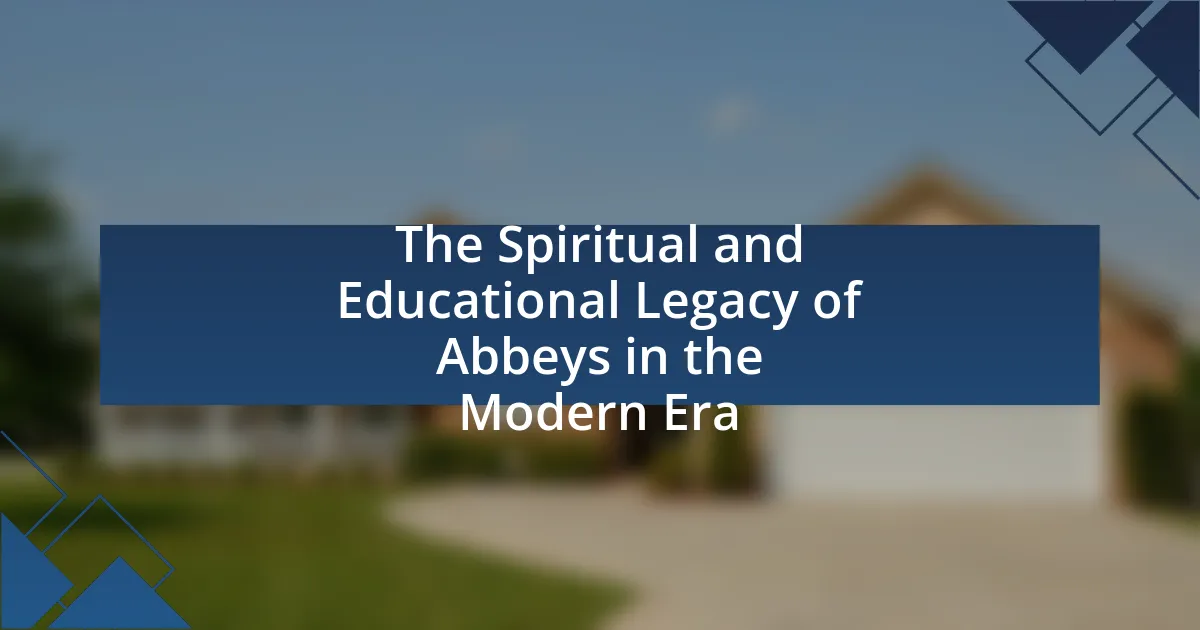The article examines the architectural evolution of abbeys, tracing their development from simple structures in the 6th century to complex designs influenced by Romanesque and Gothic styles. It highlights how abbeys served as centers of spirituality, education, and agriculture, reflecting broader historical trends and cultural contexts. Key architectural elements, such as cloisters and communal spaces, are discussed in relation to their religious significance and functionality. Additionally, the article explores the cultural impact of abbeys on local communities, their role in preserving knowledge and art, and the challenges they face in modern society, including financial sustainability and adapting to contemporary needs.

What is the Architectural Evolution of Abbeys?
The architectural evolution of abbeys reflects significant changes in design, function, and cultural context from the early medieval period to the present. Initially, abbeys were simple structures built in the 6th century, characterized by basic layouts and local materials, primarily serving monastic communities. As the Romanesque style emerged in the 10th century, abbeys began to feature thicker walls, rounded arches, and barrel vaults, exemplified by the Abbey of Cluny in France, which became a model for monastic architecture.
The Gothic period, starting in the 12th century, introduced innovations such as pointed arches, ribbed vaults, and flying buttresses, allowing for taller and more light-filled structures, as seen in the Abbey of Saint-Denis. This evolution continued into the Renaissance and Baroque periods, where abbeys incorporated classical elements and ornate decorations, reflecting the cultural shifts of the time.
In the 19th and 20th centuries, the revival of interest in monastic life led to the construction of new abbeys, often blending traditional styles with modern materials and techniques. The architectural evolution of abbeys thus mirrors broader historical trends, showcasing the interplay between religious function and artistic expression throughout the centuries.
How did abbeys originate and develop over time?
Abbeys originated in the early Christian era as monastic communities dedicated to religious life, primarily influenced by the Rule of Saint Benedict established in the 6th century. These communities developed over time into significant centers of spirituality, education, and agriculture, often featuring distinct architectural styles that reflected their cultural and regional contexts. For instance, the Romanesque style characterized early abbeys with thick walls and rounded arches, while later Gothic abbeys showcased pointed arches and flying buttresses, illustrating the evolution of architectural techniques and aesthetic preferences. The establishment of abbeys also played a crucial role in the spread of Christianity across Europe, as they served as hubs for missionary activities and cultural exchange, thereby shaping the social and economic landscapes of their regions.
What architectural styles influenced the design of early abbeys?
Early abbeys were primarily influenced by Romanesque and Gothic architectural styles. Romanesque architecture, characterized by its thick walls, rounded arches, and sturdy pillars, provided the foundational design elements for many early abbeys built during the 10th to 12th centuries. The transition to Gothic architecture in the 12th century introduced features such as pointed arches, ribbed vaults, and flying buttresses, which allowed for taller structures and larger windows, enhancing the spiritual ambiance within abbeys. Historical examples include the Abbey of Cluny, which exemplifies Romanesque design, and the Abbey of Saint-Denis, which showcases early Gothic elements, illustrating the evolution of abbey architecture influenced by these styles.
How did the function of abbeys shape their architectural features?
The function of abbeys significantly shaped their architectural features by prioritizing communal worship, monastic living, and self-sufficiency. These functions led to the design of large churches for liturgical activities, cloisters for meditation and community life, and functional spaces like kitchens and refectories to support the monks’ daily needs. For instance, the Romanesque style, prevalent in early abbeys, featured thick walls and small windows to create a solemn atmosphere conducive to prayer, while later Gothic designs incorporated large stained glass windows to enhance the spiritual experience through light. The architectural evolution reflects the abbeys’ roles as centers of religious life, education, and agriculture, demonstrating how their functions directly influenced their structural characteristics.
What are the key architectural elements of abbeys?
The key architectural elements of abbeys include the church, cloister, chapter house, refectory, and dormitory. The church serves as the central place of worship, often featuring a nave, transept, and apse, which are typical in Gothic and Romanesque styles. The cloister is an enclosed courtyard that connects various monastic buildings, providing a space for meditation and community. The chapter house is where monks gather for meetings and discussions, typically designed with acoustics in mind. The refectory is the dining hall, often adorned with religious art, while the dormitory houses the monks, emphasizing communal living. These elements reflect the functional and spiritual needs of monastic life, showcasing architectural styles that evolved from the early medieval period to the Gothic era, with notable examples like the Abbey of Cluny and Westminster Abbey illustrating these characteristics.
What role do cloisters play in abbey architecture?
Cloisters serve as essential components in abbey architecture, primarily functioning as covered walkways that connect various parts of the abbey, such as the church, chapter house, and dormitory. This architectural feature facilitates the movement of monks while providing a tranquil space for contemplation and prayer. Historically, cloisters were designed to create a serene environment, often featuring gardens or courtyards, which enhanced the spiritual experience of monastic life. The presence of cloisters in abbeys can be traced back to the early medieval period, reflecting the monastic emphasis on community and solitude, thus underscoring their significance in the overall design and function of abbeys.
How do the layouts of abbeys reflect their religious significance?
The layouts of abbeys reflect their religious significance through their design, which emphasizes communal worship, monastic life, and spiritual hierarchy. Abbeys typically feature a central church, cloisters, and various functional spaces arranged to facilitate both communal and individual religious practices. For instance, the orientation of the church towards the east symbolizes the resurrection of Christ, while the layout promotes a sense of order and discipline essential to monastic life. Historical examples, such as the Abbey of Cluny, illustrate how the architectural elements, including the transept and apse, were designed to enhance the liturgical experience, thereby reinforcing the abbey’s role as a center of spiritual authority and community life.
What historical events impacted the architectural evolution of abbeys?
The architectural evolution of abbeys was significantly impacted by the rise of monasticism in the early Middle Ages, particularly during the establishment of the Benedictine Order in the 6th century. This movement emphasized communal living and prayer, leading to the construction of larger, more complex structures to accommodate monastic life. The Carolingian Renaissance in the 8th and 9th centuries further influenced abbey architecture by promoting classical styles and the use of stone, resulting in the development of Romanesque architecture characterized by thick walls and rounded arches. The Gothic period in the 12th century introduced innovations such as flying buttresses and ribbed vaults, allowing for taller and more light-filled spaces, which were exemplified in abbeys like Saint-Denis. Additionally, the Protestant Reformation in the 16th century led to the decline of many abbeys, altering their architectural significance and use, as many were repurposed or fell into disrepair. These historical events collectively shaped the design, function, and cultural relevance of abbeys throughout history.
How did the Reformation influence abbey architecture?
The Reformation significantly influenced abbey architecture by promoting a shift from elaborate, ornate designs to simpler, more functional structures. This transformation stemmed from the Reformation’s emphasis on personal faith and scripture over ritual, leading to the reduction of monastic buildings and the repurposing of existing abbeys for Protestant worship. For instance, many Catholic abbeys were stripped of their decorative elements and altars, reflecting the new theological priorities. The architectural changes also included the incorporation of features that facilitated congregational participation, such as open spaces and clear sightlines, which were less common in the previous Catholic designs. This shift is evidenced by the conversion of many abbeys into parish churches, where the focus was on the sermon rather than the sacramental rituals that had previously dominated Catholic worship.
What role did monastic orders play in the architectural development of abbeys?
Monastic orders significantly influenced the architectural development of abbeys by establishing design principles that emphasized functionality, spirituality, and community. These orders, such as the Benedictines and Cistercians, prioritized the creation of spaces conducive to prayer, work, and communal living, leading to the development of specific architectural features like cloisters, refectories, and chapels. For instance, the Cistercian order, founded in the 11th century, promoted simplicity and austerity in design, which resulted in the use of plain stone and minimal ornamentation, as seen in the Abbey of Fontenay. This architectural approach not only reflected their spiritual values but also set a precedent for future abbey constructions across Europe, demonstrating the lasting impact of monastic orders on ecclesiastical architecture.

What is the Cultural Impact of Abbeys?
Abbeys have significantly influenced culture by serving as centers of education, art, and community life. Historically, abbeys were instrumental in preserving knowledge during the Middle Ages, as monks copied manuscripts and maintained libraries, which contributed to the intellectual revival of Europe. Additionally, abbeys often commissioned and housed remarkable works of art, including illuminated manuscripts and religious paintings, which have shaped artistic traditions. The architectural styles of abbeys, such as Romanesque and Gothic, have also left a lasting legacy on European architecture, influencing the design of churches and public buildings. Furthermore, abbeys fostered a sense of community and spirituality, often becoming focal points for local culture and traditions, which continue to resonate in contemporary society.
How have abbeys influenced local cultures and communities?
Abbeys have significantly influenced local cultures and communities by serving as centers of education, agriculture, and social services. Historically, abbeys were often the primary institutions for learning, where monks preserved and copied texts, thus contributing to the intellectual development of their regions during the Middle Ages. For example, the Abbey of Cluny in France became a model for monastic reform and education, impacting numerous communities across Europe. Additionally, abbeys played a crucial role in agricultural innovation, introducing advanced farming techniques and crop rotation, which improved local food production and sustainability. The Cistercian abbeys, known for their agricultural practices, transformed landscapes and economies in areas like England and France. Furthermore, abbeys provided social services, such as hospitality for travelers and care for the poor, fostering a sense of community and support. This multifaceted influence of abbeys has left a lasting legacy on local cultures and communities, shaping their social, economic, and educational frameworks.
What cultural practices originated in or were promoted by abbeys?
Cultural practices that originated in or were promoted by abbeys include monasticism, manuscript illumination, and agricultural innovations. Monasticism, as a structured religious life, was central to abbeys, fostering spiritual discipline and community living. Manuscript illumination flourished in abbeys, where monks meticulously copied and decorated texts, preserving knowledge and art during the Middle Ages. Additionally, abbeys often implemented advanced agricultural techniques, such as crop rotation and animal husbandry, which contributed to local economies and food production. These practices not only shaped the cultural landscape of their time but also laid the groundwork for future developments in education, art, and agriculture.
How do abbeys serve as centers of education and learning?
Abbeys serve as centers of education and learning by providing structured environments for scholarly pursuits, often housing libraries, scriptoria, and schools. Historically, many abbeys were established during the Middle Ages as monastic communities dedicated to religious life, but they also prioritized the preservation and dissemination of knowledge. For instance, the Abbey of Cluny in France, founded in 910, became a significant center for learning, influencing monastic education across Europe. Additionally, abbeys often employed monks as educators who taught theology, philosophy, and the liberal arts, contributing to the intellectual revival of the period. This dual role of spiritual and educational leadership solidified abbeys as pivotal institutions in the development of Western education.
What is the significance of abbeys in art and literature?
Abbeys hold significant importance in art and literature as they symbolize spiritual refuge, community, and the intersection of the sacred and the secular. In art, abbeys often serve as subjects that reflect architectural grandeur and the monastic lifestyle, influencing styles from Gothic to Baroque, as seen in works like the illuminated manuscripts produced in abbeys during the Middle Ages. In literature, abbeys frequently represent settings for introspection, moral dilemmas, and the exploration of faith, as illustrated in texts such as “The Name of the Rose” by Umberto Eco, which intricately weaves the abbey’s architecture into its narrative. The historical role of abbeys as centers of learning and culture further enhances their significance, as they preserved and produced literary works, contributing to the intellectual heritage of Europe.
How have abbeys been depicted in various art forms throughout history?
Abbeys have been depicted in various art forms throughout history, showcasing their architectural grandeur and spiritual significance. In medieval illuminated manuscripts, abbeys were illustrated to reflect their role as centers of monastic life, often featuring detailed depictions of their structures and the activities of monks. Renaissance paintings frequently portrayed abbeys as symbols of tranquility and divine order, emphasizing their harmonious integration with nature. Additionally, Gothic architecture, characterized by pointed arches and intricate facades, visually represented the spiritual aspirations of abbeys, influencing artists and architects alike. Notably, the works of artists such as Claude Monet captured the ethereal beauty of abbeys in landscapes, further solidifying their cultural impact.
What literary works have been inspired by abbeys and their surroundings?
Literary works inspired by abbeys and their surroundings include “The Name of the Rose” by Umberto Eco, which is set in a 14th-century Benedictine monastery and explores themes of faith, knowledge, and power. Additionally, “The Monk” by Matthew Lewis features an abbey as a central location, delving into the darker aspects of religious life. “The Abbey” by James Hogg also reflects on the influence of abbeys, portraying the tension between the sacred and the secular. These works illustrate how abbeys serve as significant backdrops for exploring complex themes in literature.
How do abbeys contribute to modern cultural heritage?
Abbeys contribute to modern cultural heritage by serving as historical landmarks that embody architectural styles, religious practices, and community values from their time of construction. These structures often showcase unique design elements, such as Gothic arches and Romanesque features, which reflect the artistic and engineering advancements of their eras. For instance, the Abbey of Westminster in London, built in the 10th century, is not only a site of royal ceremonies but also a prime example of English Gothic architecture, influencing contemporary building designs. Additionally, abbeys often house significant artworks, manuscripts, and artifacts that provide insight into the cultural and spiritual life of past societies, thereby enriching our understanding of history and heritage.
What role do abbeys play in contemporary tourism and heritage conservation?
Abbeys serve as significant attractions in contemporary tourism and play a crucial role in heritage conservation. They draw millions of visitors annually, contributing to local economies and promoting cultural awareness. For instance, UNESCO World Heritage Sites, such as the Abbey of Monte Cassino in Italy, highlight the architectural and historical importance of abbeys, ensuring their preservation through tourism revenue. Additionally, abbeys often host educational programs and events that foster appreciation for their historical context, further supporting conservation efforts.
How are abbeys preserved and maintained for future generations?
Abbeys are preserved and maintained for future generations through a combination of restoration efforts, conservation practices, and community engagement. Restoration involves repairing and restoring the original architectural features using traditional materials and techniques, ensuring historical accuracy. Conservation practices include regular maintenance, climate control, and pest management to protect the structures from deterioration. Community engagement fosters public interest and support, often leading to fundraising initiatives and volunteer programs that contribute to the upkeep of abbeys. For instance, many abbeys are designated as UNESCO World Heritage Sites, which provides them with additional funding and resources for preservation efforts.

What are the Future Trends in Abbey Architecture and Culture?
Future trends in abbey architecture and culture include a focus on sustainability, adaptive reuse, and community engagement. Architects are increasingly designing abbeys with eco-friendly materials and energy-efficient systems, reflecting a broader societal shift towards environmental responsibility. For instance, the integration of renewable energy sources, such as solar panels, is becoming common in new constructions and renovations of historical abbeys. Additionally, the adaptive reuse of abbey buildings for modern purposes, such as community centers or boutique hotels, is gaining traction, allowing these structures to serve contemporary needs while preserving their historical significance. This trend not only revitalizes the cultural relevance of abbeys but also fosters community involvement and tourism, enhancing their role as cultural hubs.
How is modern architecture influencing the design of new abbeys?
Modern architecture is influencing the design of new abbeys by integrating contemporary materials, sustainable practices, and minimalist aesthetics. This shift reflects a broader trend in architecture that emphasizes functionality and environmental consciousness, aligning with the spiritual and communal purposes of abbeys. For instance, the use of glass and steel allows for natural light to permeate spaces, fostering a sense of openness and connection to nature, which is essential in monastic life. Additionally, sustainable design principles, such as energy-efficient systems and eco-friendly materials, are increasingly incorporated, as seen in projects like the Abbey of Saint John in the Netherlands, which utilizes renewable energy sources. These modern elements not only enhance the aesthetic appeal but also resonate with the values of modern spirituality and community engagement.
What sustainable practices are being adopted in abbey construction and maintenance?
Sustainable practices in abbey construction and maintenance include the use of locally sourced materials, energy-efficient designs, and water conservation systems. These practices aim to minimize environmental impact while preserving historical integrity. For instance, many abbeys now incorporate renewable energy sources such as solar panels and geothermal heating, which reduce reliance on fossil fuels. Additionally, rainwater harvesting systems are increasingly implemented to manage water resources effectively. These approaches not only enhance sustainability but also align with the growing emphasis on environmental stewardship in architectural practices.
What challenges do abbeys face in the modern world?
Abbeys face several challenges in the modern world, including financial sustainability, declining monastic populations, and the need to adapt to contemporary societal values. Financial sustainability is a significant issue, as many abbeys rely on tourism and donations, which can fluctuate. For instance, a report from the European Union indicated that religious sites, including abbeys, saw a 30% drop in visitor numbers during the COVID-19 pandemic, impacting their revenue streams. Additionally, declining monastic populations pose a challenge to maintaining traditional practices and community life, with many abbeys struggling to attract new members. Lastly, abbeys must navigate the tension between preserving historical architecture and adapting to modern needs, which can lead to conflicts over conservation versus accessibility.
How can abbeys adapt to changing cultural and societal needs?
Abbeys can adapt to changing cultural and societal needs by repurposing their spaces for community engagement and modern functions. For instance, many abbeys have transformed their facilities to host events, workshops, and retreats that reflect contemporary interests, such as mindfulness and sustainability. This adaptation is supported by historical precedents where abbeys served as centers of learning and community support, demonstrating their ability to evolve with societal demands. Additionally, integrating technology and offering digital resources can further enhance their relevance in today’s society, as seen in various abbeys that provide online access to their archives and educational programs.
What best practices can be applied to preserve the architectural and cultural significance of abbeys?
To preserve the architectural and cultural significance of abbeys, best practices include implementing conservation techniques, engaging in community involvement, and promoting adaptive reuse. Conservation techniques, such as using traditional materials and methods, ensure that restoration efforts maintain the original design and craftsmanship, which is crucial for historical integrity. Community involvement fosters local stewardship and awareness, as seen in successful projects where local groups participate in preservation efforts, enhancing cultural appreciation. Adaptive reuse allows abbeys to serve contemporary functions while respecting their historical context, as demonstrated by several abbeys being transformed into cultural centers or hotels, thus ensuring their sustainability and relevance in modern society.





